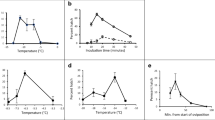Abstract
Second stage larvae of Toxocara canis were isolated from developed eggs, frozen in Eagle's Minimal Essential Medium with 5% dimethyl sulfoxide or 10% glycerol as cryoprotectants according to two cooling schedules and maintained in liquid nitrogen for 1 week. After thawing, the previously frozen larvae (FL) and unfrozen controls (CL) were maintained in a chemically defined medium in vitro for 35 weeks. While CL had motility rates around 95% to 97% throughout the experiment, previously frozen larvae (FL) exhibited rates of 48%–58% at the beginning and of 19%–39% at the end of the 35 week in vitro maintenance period. The surviving FL and CL larvae proved to be infective for mice. Excretory/secretory (ES) antigens isolated from several batches of culture medium in which FL and CL had been maintained reacted in the ELISA with human sera containing antibodies against Toxocara. Antigens from FL and CL separated by SDS-PAGE and silver-stained showed some differences in polypeptide patterns. Western-blot analysis revealed that these differences were not related to antigenic polypeptides but were most likely caused by substances without antigenic properties originating from dead and/or degenerating larvae. It can be concluded that ES antigens produced by previously frozen larvae are essentially the same as those derived from unfrozen controls.
The value of cryopreservation of T. canis larvae for routine production of ES antigens will be further evaluated.
Similar content being viewed by others
References
Annen JM, Eckert J, Hess U (1975) Eine einfache Methode zur Gewinnung von Toxocara canis-Antigen für die indirekte Immunfluoreszenz-Technik. Acta Trop (Basel) 32:37–47
Ashwood-Smith MJ, Farrant J (eds) (1980) Low Temperature Preservation in Medicine and Biology. Pitman Medical, Tunbridge-Wells/UK
Boch J, Supperer R (1983) VeterinÄrmedizinische Parasitologie. 3. Aufl. P. Parey, Berlin
De Savigny DH (1975) In vitro maintenance of Toxocara canis larvae and a simple method for the production of Toxocara ES antigen for use in serodiagnostic tests for visceral larva migrans. J Parasitol 61:781–782
De Savigny DH, Tizard IR (1977) Toxocaral larva migrans: the use of larval secretory antigens in haemagglutination and soluble antigen fluorescent antibody tests. Trans R Soc Trop Med Hyg 71:501–507
De Savigny DH, Voller A, Woodruff AW (1979) Toxocariasis: serological diagnosis by enzyme immunoassay. J Clin Pathol 32:284–288
Eckert J, Ramp T (1985) Cryopreservation of Echinococcus multilocularis metacestodes and subsequent proliferation in rodents (Meriones). Z Parasitenkd 71:777–787
Glickman LT, Schantz PM (1985) Do Toxocara canis larval antigens used in enzyme-linked immunosorbent assay for visceral larva migrans cross-react with AB isohemagglutinins and give false positive result? Z Parasitenkd 71:395–400
Gottstein B, Tsang VCW, Schantz PM (1986) Demonstration of species-specific and cross-reactive components of Taenia solium metacestode antigens. Am J Trop Med Hyg 35:308–313
James ER (1980) Protozoa and helminths. Parasites of man and animals. In: Ashwood-Smith MJ and Farrant J (eds), Low Temperature Preservation in Medicine and Biology. Pitman Medical Tunbridge-Wells/UK, pp 155–185
James ER (1985) Cryopreservation of helminths. Parasitol Today 1:134–139
Leef JL, Hollingdale MR, Beaudoin RL (1981) Principles of cryopreservation of protozoan parasites and erythrocytes. Wld Hlth Org Document Mal 81. 940
Maizels RM, de Savigny D, Ogilvie BM (1984) Characterization of surface and excretory-secretory antigens of Toxocara canis infective larvae. Parasite Immunol 6:23–37
Smith HV, Kusel JR, Girdwood RWA (1983) The production of human A and B blood group like substances by in vitro maintained second-stage Toxocara canis larvae: their presence on the outer larval surfaces and in their excretions/secretions. Clin Exp Immunol 54:625–633
Speiser F, Gottstein B (1984) A collaborative study on larval excretory/secretory antigens of Toxocara canis for the immunodiagnosis of human toxocariasis with ELISA. Acta Trop (Basel) 41:361–372
van Knapen F, van Leusden J, Polderman AM, Franchimont JH (1983) Visceral larva migrans: examinations by means of enzyme-linked immunosorbent assay of human sera for antibodies to excretory-secretory antigens of the secondstage larvae of Toxocara canis. Z Parasitenkd 69:113–118
Author information
Authors and Affiliations
Rights and permissions
About this article
Cite this article
Ramp, T., Eckert, J. & Gottstein, B. Cryopreservation and long-term in vitro maintenance of second-stage larvae of Toxocara canis . Parasitol Res 73, 165–170 (1987). https://doi.org/10.1007/BF00536474
Accepted:
Issue Date:
DOI: https://doi.org/10.1007/BF00536474




